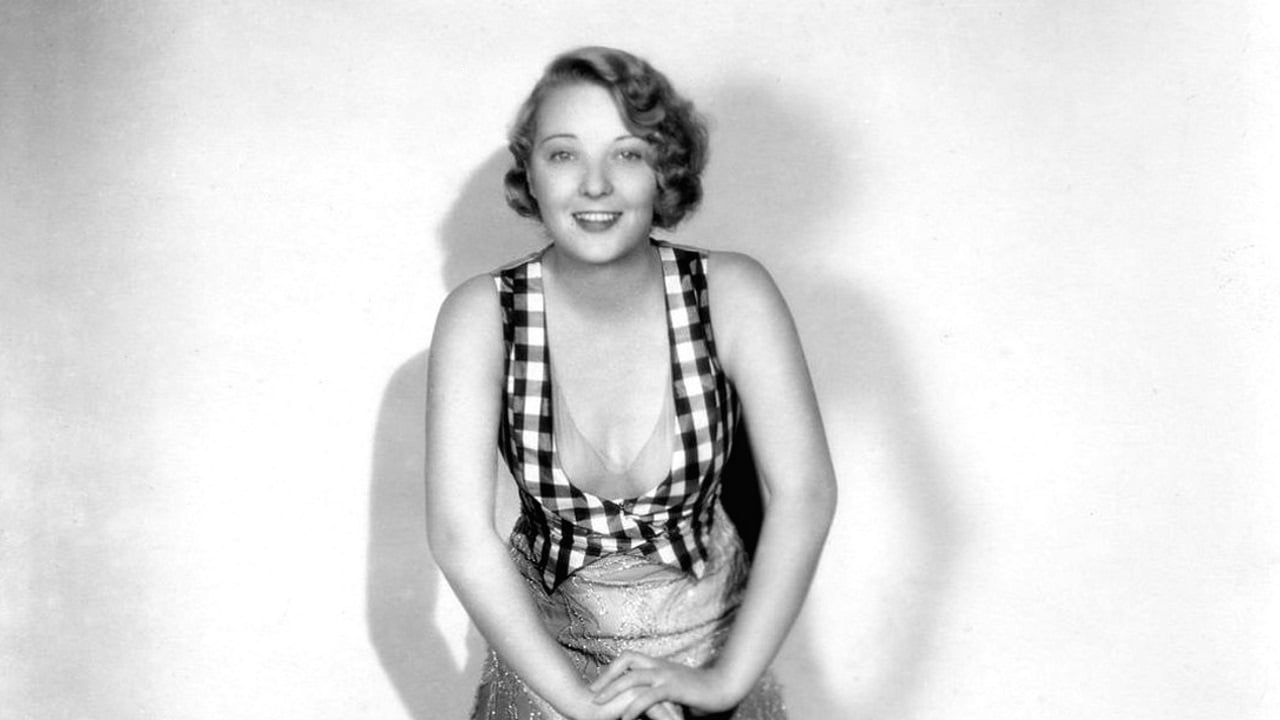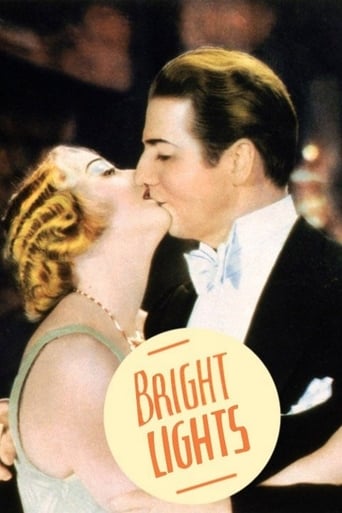

everything you have heard about this movie is true.
... View Moreif their story seems completely bonkers, almost like a feverish work of fiction, you ain't heard nothing yet.
... View MoreWorth seeing just to witness how winsome it is.
... View MoreThis is a coming of age storyline that you've seen in one form or another for decades. It takes a truly unique voice to make yet another one worth watching.
... View MoreThe title actually says "Adventures in Africa", but it's listed on Turner Classics as "Bright Lights!". and the trivia says there's a lost technicolor version, but personally i'm glad its in glorious black and white... i like my early talkies to be in charming but ancient black and white. a bare minimum of a story. In this show-within-a-show, Frank Fay is Wally, the emcee of the big production. Dorothy Mackaill is Louanne, about to leave the show and marry into money. the other big names are Noah Beery as the interloper, and funny guy Frank McHugh as the reporter, always lurking about. he's listed way down in the credits, but he's in almost every scene. one of his first roles in hollywood. This was before any film code, so there's an abundance of cleavage and walking around in night-gowns. one of the running gags is the Averys, husband and wife who are continually nagging each other. LOTS of song and dance numbers, but it keeps moving along. it's fun... light and fluffy. A Curtiz production... probably his best known films were Casablanca and Yankee Doodle Dandy.
... View More"Bright Lights" (re-named "Adventures in Africa" for TV broadcasting many years after its release) is a cinematic Mulligan stew consisting of a murder mystery, multiple love stories, several musical numbers, and tedious stretches of low comedy barely held together by a witless and improbable script about a show girl (Dorothy Mackaill) who, with her partner- manager (Frank Fay) shimmies her way from small-time tropical dives and traveling carnivals to the Broadway big-time only to announce that she's giving up the stage to marry into wealth (in the person of Philip Strange as Mr. Emerson Fairchild of Long Island whose accent is British but whose mother's is Midlantic). The Fay character loves and protects Mackaill in a fatherly or businesslike manner but refrains from marrying her; every time he is about to give in to that urge he pulls back because some part of him senses that he is not worthy to be her husband. Mackaill finds his hot/cold behavior frustrating and infuriating. The development of this complex relationship takes a back seat to sometimes heavy-handed subplots enacted by the likes of Eddie Nugent in an ill-defined role (star's press agent?) eagerly trying to manage a gaggle of reporters which includes a barely visible young John Carradine and an all-too-visible Frank McHugh as an obnoxious drunk, who have assembled to cover Mackaill's final performance; James Murray and Inez Courtney as young lovers; Tom Dugan and Daphne Pollard as a violently discordant married dance team; Noah Beery as a lecherous figure from Mackaill's and Fay's sordid African past. Other, later, pre-Code films with similar elements include "I'm No Angel," "Forty-Second Street," "Murder at the Vanities" and Mackaill's outstanding 1932 feature "Safe in Hell."As far as the songs go, "Wall Street" near the beginning, despite a stage-filling chorus and carloads of set pieces and costumes, falls flat, even with expert song-and-dance man Fay at the center. He comes off better in the Harry Akst-Grant Clarke standard "Nobody Cares If I'm Blue." In dramatic scenes, however, his haggard appearance distracts from his emotionally nuanced performance. The makeup applied to his rugged features suggests Count Dracula and clashes with his gently rapid speaking voice and smooth singing style and stage manner. Among the other musical numbers, "Song of the Congo," "I'm Crazy for Cannibal Love" and "I'm Just a Man About Town" are the catchiest, both visually and melodically, though one can't help wondering what Busby Berkeley might have done with the staging. Mackaill is the centerpiece of all three; she performs a hula-type dance in the first two and wears a man's tux and top hat in the first half of the latter before emerging via camera trickery from the huddle of a male chorus wearing a dress. She also has some effective dramatic moments but, due perhaps to sloppy editing, misfires during a poorly staged dressing room temper tantrum. Her vocal range is limited, but she carries her songs confidently, dances gamely and looks magnificent in skimpy, spangled costumes as well as in screen-filling closeups.
... View MoreAs I sat and watched "Bright Lights", I did what I often do--checked out the IMDb reviews for the film. Imagine my surprise when I noticed several reviews which gave this film extremely high scores...too high. It made me wonder if we were watching the same film, as "Bright Lights" was just awful--dated, dull and among the worst early musicals I've ever seen. It lacks polish and is flat but more importantly, it abounds with overacting. How anyone could give this silly film a 10 is beyond me. It obviously is a transitional film--one where the folks who made the film still haven't figured out exactly how to do a musical. The choreography is pretty lousy, the sound quite flat and the story lacks so much.By the way, if you are wondering, I love old movies--especially early talking pictured. It's just that I don't like this particular one!
... View MoreMaria Montez was once quite rightly dubbed Queen of Technicolor. As for the King? Well, there was a King, true, but he wasn't an actor (at least not a regular actor). He was director Michael Curtiz, called the King of Technicolor because it was claimed he directed more Technicolor (two-strip and three-strip Technicolor, that is) movies than anyone else. A difficult assertion to prove or disprove. Certainly Curtiz was King of Technicolor on the Warner Bros. lot. Maybe over-all. I'll leave that for some other researcher to ponder. What we do know for a fact is that 1930 was one of Technicolor's greatest years. Sixteen full-length features plus one, M-G-M's The March of Time shelved and never released, plus eighteen features with Technicolor sequences, totals thirty-five — a figure not exceeded until 1948. Warner Bros.-First National were responsible for no less than sixteen of these Technicolor releases, but only three were directed by Curtiz: Bright Lights, Under a Texas Moon and sequences in Mammy. Just about all the Warner-First National output were musicals (no wonder the public tired of the genre so quickly in 1930). Bright Lights is no exception. It's a shame in fact that even more songs weren't packed in to edge out even more of the silly story. It would have to be the most stupid, most idiotic, most unbelievable, most melodramatically ridiculous plot I've ever encountered. At least it's original. No-one would ever want to copy or imitate it, that's for sure!However, the story does allow us to evaluate the players, particularly lovely, charismatic, almost forgotten, British-born Dorothy Mackaill, a big star in silents who made the transition to sound with no problems at all, but was left on the sidelines when Warner Brothers bought out First National and began trimming National's star roster at the height of the Depression. Another problem – not of Dorothy's making, but entirely the fault of Jack Warner – was that her vehicles were not popular with the public. This one, chock-a-bloc with elaborate production numbers, hit theaters when the public was absolutely fed up with musicals. Hence a desperate title change to Adventures in Africa which was not only inappropriate – the "African" footage didn't amount to more than ten minutes – but wildly deceptive. So who did people blame? Jack Warner? No! Mike Curtiz? No! "Humph" Pearson and Henry McCarty? No! Even over-zealous Frank Fay who out-stays his welcome. No! This was only Fay's third feature film, and he had no box office drawing power anyway. For 99% of moviegoers, Dorothy Mackaill was number one on their hit list. My dad thought that the sole function of producers was to shell out the money and that directors were in charge of photography and other technical aspects. As for the stars – they made up their own scripts and directed themselves! And those notions was shared by almost the entire line-up of rank-and-file picturegoers. So if they hated Adventures in Africa – which they did (in spades) – the number one (and perhaps only) figure on their hate lists was Dorothy Mackaill. True, Frank McHugh's inebriated reporter hit the spot, but his routines ranked a poor second to all that singing and dancing – which you and I love, but which back in 1931, just about everyone from critics to choir boys hated!
... View More